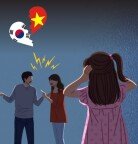Emergency Measures for Injured Children
Emergency Measures for Injured Children
Posted April. 30, 2007 03:43,

May is a perfect time for family outings. But children can suffer unexpected injury outdoors. Injury in children could damage their growth, causing serious side effects. You can reduce the risks by taking the right emergency measures at the right time.
Do not solely depend on oriental medicine for fractures-
Fractures among adults tend to lead to damaged ligaments. But when children suffer fractures, they usually have broken or dislocated bones. You can determine whether an adult has a fracture just by touching the affected area. But it is not easy to determine a childs fracture in the same way because children have weaker and thinner bones.
If a child suffers an arm injury and the injured arm is immovable and swelling, it is highly likely that the arm is fractured. In such cases, you should immediately take the child to an orthopedist. Childrens bones are still soft, so the broken bones will easily heal. However, if you mistake the fracture for a simple sprain and depend on oriental medicine or just take emergency measures, the bones could be fixed in the wrong form. Once that happens, it can be hard to undo the damage, even if you go to an orthopedist later. As the bones of those aged 15 or younger are still growing, their cartilage bones do not appear on x-ray images. Even if a doctor treats an injured child, parents should carefully watch the child. There are growth plates near joints. The growth plate could be damaged when a child suffers an injury around a joint. As childrens fractures are usually treated by using casts rather than through surgery, parents should carefully check if the growth plate is damaged.
Flood the eyes with water when chemicals splash in them-
First, you should check if the eye is bleeding. If the eye is bleeding, you should have the child close the eye and cover the eye with protective glasses or goggles to block external irritants, and take the child immediately to a doctor. If blood comes out from between the pupil and the iris, that could mean a damaged eyeball.
If the eye is not bleeding, you should prevent the child from rubbing the eye and tilt the childs head back. You should flood the eye with saline solution if a foreign substance is in the eye. If sand is in the eye, you should take the child to a doctor because bacteria in the sand could cause inflammation. If you flood too much water or saline solution to remove large substances like metal powder, that could weaken the protective membrane in the eye. You should also see a doctor if that happens.
The first thing you should do when chemicals splash in a childs eye is clean it quickly. You can use tap water or purified water. You should clean the eye for more than 30 minutes with at least one liter of water with the eye open, and then cover the eye with a clean wet gauze before seeing a doctor.
A Scratch could leave a scar-
A scratch does not look like a big deal. But you should take the right initial measures because it could leave a scar.
First, you should prevent the child from touching the wound and clean the wound with clean water or saline solution before applying a treatment like madecassol. You should attach band-aids to prevent the child from removing the scab. If the child cut his or her hand, you should stop the bleeding with clean cloths and apply treatment. If the cut swells a lot or if the child has not had a tetanus shot, it would be better to take the child to a doctor.
When your child gets a burn, you should cool the burn with cold water before applying treatment. If the burn is serious, do not try to take the childs clothes and take the child to a hospital immediately. You should use moist band-aids for burns because you should keep the burn moist to heal it quickly.
(Advice: Song Sang-rul, Professor of the Cornea Department at Kims Eye Hospital; Song In-soo, Chief of Joint Center at Sun Hospital; Song Ho-chan, Leading Doctor at Anacli)
artemes@donga.com







